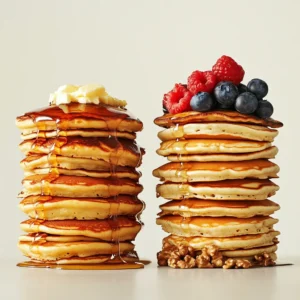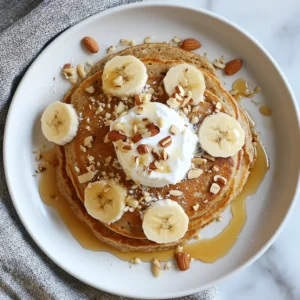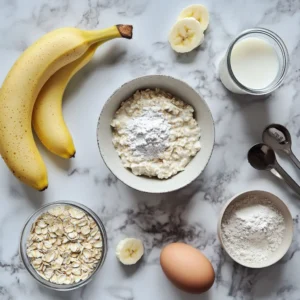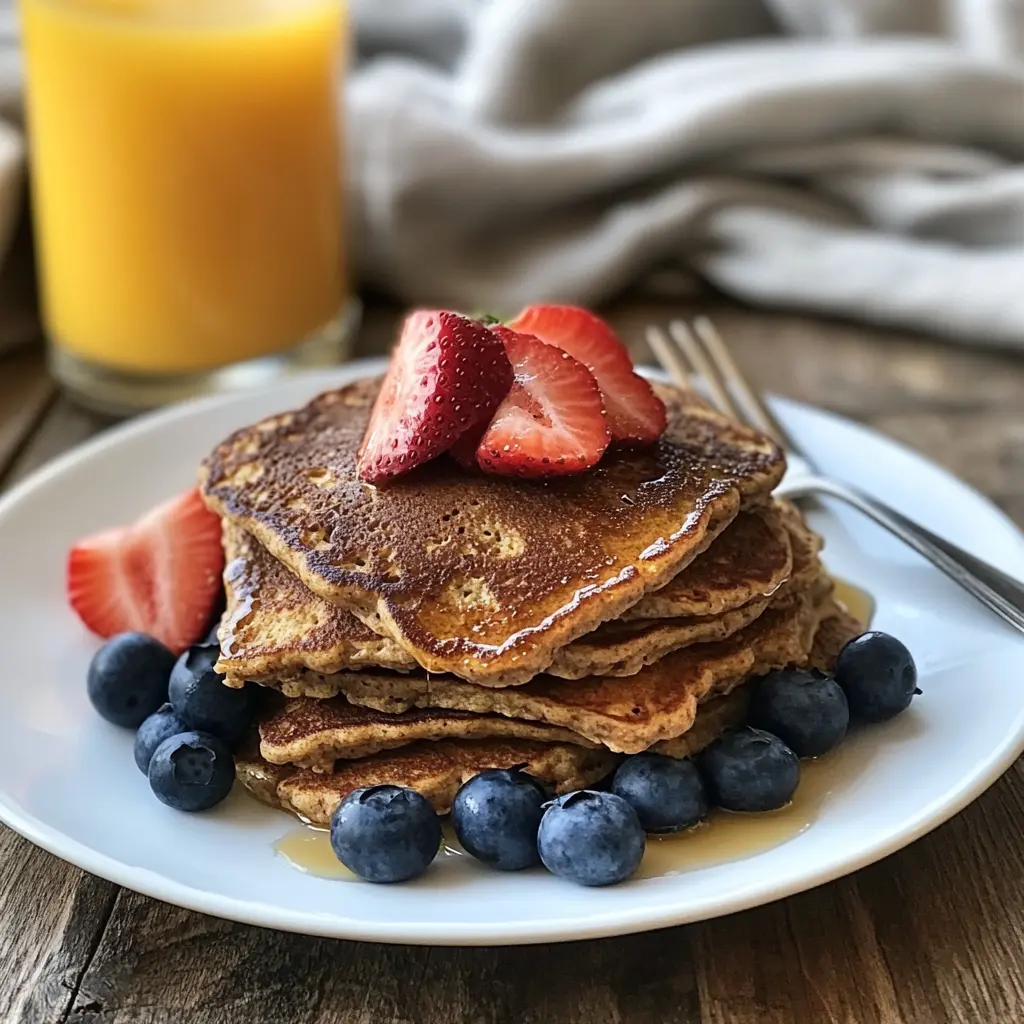Introduction
Are protein pancakes healthy? Many people are turning to these high-protein alternatives to traditional pancakes as part of their health and fitness journey. Protein pancakes use ingredients like whey protein powder, Greek yogurt, or eggs to provide a meal that’s richer in protein and lower in refined sugars and carbohydrates. This makes them a popular choice for those seeking a balanced, nutrient-dense breakfast option.
In this article, we’ll explore whether protein pancakes are truly healthy, examining their nutritional benefits, potential drawbacks, and how to prepare them in the best way possible.
Nutritional Profile of Protein Pancakes

Comparison with Traditional Pancakes
Protein pancakes stand apart from traditional recipes by incorporating protein-rich ingredients such as whey protein powder, Greek yogurt, or eggs. These substitutions increase the protein content while reducing added sugars and refined carbohydrates, resulting in a more balanced and satisfying meal. Protein pancakes offer a healthier option for those looking to support fitness goals, maintain satiety, or enjoy a nutrient-dense breakfast.
Key Ingredients in Protein Pancakes
The composition of protein pancakes varies widely, but typical recipes include:
- Protein Sources: Whey protein, plant-based protein powders, egg whites, or cottage cheese boost the overall protein content significantly.
- Flour Alternatives: Substituting almond flour, oat flour, or whole wheat flour enhances the fiber and nutrient profile.
- Sweeteners: Natural sweeteners like mashed bananas, stevia, or honey replace refined sugar, making protein pancakes a healthier choice.
- Fats: Healthy fats from sources like peanut butter, avocado oil, or flaxseeds further improve the nutritional balance of protein pancakes.
Protein Content Analysis
Protein pancakes typically contain 15–30 grams of protein per serving, depending on the recipe, compared to the 5–7 grams found in traditional pancakes. This makes them an excellent choice for breakfast or post-workout meals, supporting muscle recovery, satiety, and sustained energy levels. By using protein-rich alternatives, protein pancakes achieve a nutritional edge over their traditional counterparts.
The protein content helps to:
- Support muscle repair and growth: Essential for those who work out.
- Promote satiety: Keeping you full longer and reducing the likelihood of overeating.
By understanding the nutritional profile, it’s clear that protein pancakes offer a healthier alternative to traditional pancakes, provided they are made with wholesome ingredients.
Health Benefits of Protein Pancakes
High-Protein Diets and Muscle Health
Protein is a cornerstone of muscle repair and growth, making protein pancakes an ideal choice for active individuals. Consuming a high-protein meal like this after a workout can aid muscle recovery and support overall fitness goals. Moreover, regular protein intake helps maintain lean muscle mass, especially during weight loss or aging.
Promoting Satiety and Weight Management

One of the standout benefits of protein pancakes is their ability to keep you feeling full for longer periods. Protein slows down digestion and reduces the release of hunger hormones, making it easier to manage calorie intake. For those aiming to lose or maintain weight, starting the day with a protein-packed breakfast can help prevent unhealthy snacking later on.
Versatility in Nutritional Customization
Protein pancakes are incredibly versatile. You can tailor the recipe to meet specific dietary needs, including:
- Low-carb diets: Use almond flour and a low-carb sweetener.
- Vegan diets: Opt for plant-based protein powder and flaxseed meal as an egg substitute.
- Gluten-free options: Choose oat or coconut flour to avoid gluten.
This adaptability makes protein pancakes accessible and appealing to a wide range of dietary preferences.
Packed with Nutrients
Protein pancakes often incorporate nutrient-dense ingredients like fruits, nuts, seeds, or even vegetables (e.g., zucchini or sweet potato puree). These additions boost the content of essential vitamins, minerals, and antioxidants, offering more than just protein.
Enhanced Energy and Focus
Combining protein with slow-digesting carbohydrates from ingredients like oats provides a steady energy release. This can enhance focus and productivity throughout the morning, making protein pancakes an excellent choice for busy days.
While protein pancakes bring several health benefits, it’s crucial to balance them with mindful ingredient choices and portion sizes to maximize their positive impact.
Potential Drawbacks of Protein Pancakes
Added Sugars and Unhealthy Fats in Some Recipes
Not all protein pancakes are created equal. While many recipes focus on health, some commercially available or pre-packaged mixes can contain:
- Excess sugar: To improve taste, some products use artificial sweeteners or refined sugars that negate health benefits.
- Unhealthy fats: Hydrogenated oils or excessive butter can add unnecessary calories and harmful trans fats.
Always check the nutritional label of store-bought products or scrutinize recipes to ensure they align with your dietary goals.
Allergens in Protein Powders
Protein powders are a common ingredient in protein pancakes, but they may pose a risk for individuals with allergies or sensitivities. Common allergens include:
- Dairy: Found in whey or casein protein powders, which can cause discomfort for those with lactose intolerance.
- Soy: Present in some plant-based powders, a known allergen for certain individuals.
Choosing hypoallergenic or single-ingredient protein powders can mitigate this concern.
Overreliance on Processed Foods
Using protein powders or pre-made mixes to make protein pancakes may contribute to overconsumption of processed foods. While these products are convenient, they can lack the natural nutrients found in whole food sources like eggs, nuts, and seeds.
To maintain a balanced diet, it’s essential to pair protein pancakes with fresh fruits, vegetables, and other whole foods to ensure adequate fiber, vitamins, and minerals.
Digestive Issues from High-Protein Ingredients
Eating a high-protein meal can sometimes cause digestive discomfort, particularly if the pancakes are made with ingredients that are hard to digest, like:
- Artificial sweeteners: May cause bloating or gas in sensitive individuals.
- Excessive protein powders: Can strain the digestive system if consumed in large amounts.
Moderation and ingredient variety can help alleviate these issues.
Misleading “Health Halo” Effect
Just because a food is labeled as “high-protein” doesn’t necessarily mean it is healthy. Protein pancakes can still be calorie-dense, particularly if loaded with high-calorie toppings like syrup, whipped cream, or chocolate chips. Overeating these can lead to weight gain rather than the desired health benefits.
Understanding and addressing these potential drawbacks allows you to make informed decisions about incorporating protein pancakes into your diet.
Homemade vs. Store-Bought Protein Pancakes
Benefits of Making Them at Home

Homemade protein pancakes provide complete control over ingredients and nutritional content. Some advantages include:
- Customizable Nutrition: You can adjust protein, carbs, and fats to suit your dietary goals.
- Cleaner Ingredients: Avoid artificial additives, preservatives, and excess sugar found in some store-bought options.
- Allergy-Friendly: Tailor recipes to avoid allergens like gluten, dairy, or soy.
Homemade pancakes also allow you to incorporate fresh and nutrient-dense ingredients such as spinach, berries, or flaxseeds.
Common Additives in Store-Bought Varieties
While store-bought protein pancake mixes are convenient, many come with drawbacks. Watch out for:
- Preservatives: Added to extend shelf life but may impact overall health when consumed frequently.
- Artificial Sweeteners: Though calorie-free, some sweeteners can lead to digestive discomfort or a strong aftertaste.
- Thickeners and Emulsifiers: Used to improve texture, but they can be unnecessary when making pancakes from scratch.
Even the healthiest store-bought options may lack the fresh, whole ingredients you can use at home.
Cost and Convenience Comparison
- Store-Bought: These save time and effort, requiring only water or milk to prepare. However, high-quality mixes can be pricey, and cheaper versions often compromise on health benefits.
- Homemade: Preparing pancakes from scratch may take a few extra minutes, but the cost per serving is usually lower, especially when using pantry staples like oats and eggs.
Balancing Convenience with Health
For those who prefer the convenience of store-bought protein pancakes, look for brands with minimal ingredients and no added sugar. Alternatively, consider batch-preparing homemade pancakes and freezing them for a quick, healthy breakfast.
Homemade protein pancakes provide superior health benefits, while store-bought options may be useful for occasional convenience. Striking a balance between the two ensures both practicality and nutrition.
How to Make Healthy Protein Pancakes
Choosing the Right Ingredients
Creating nutritious protein pancakes starts with selecting wholesome ingredients. Here are some tips:
- Protein Source: Opt for high-quality protein powders like whey, pea, or hemp protein. Alternatively, use eggs, Greek yogurt, or cottage cheese for a natural protein boost.
- Flour Alternatives: Choose nutrient-dense flours like almond, oat, or whole wheat flour instead of refined white flour.
- Sweeteners: Use natural options such as mashed bananas, applesauce, honey, or a sprinkle of stevia for sweetness without added sugar.
- Healthy Fats: Incorporate fats like nut butter, coconut oil, or ground flaxseeds for a balanced macronutrient profile.
Balancing Macronutrients
For a well-rounded meal, aim to balance macronutrients in your protein pancakes:
- Protein: At least 15–25 grams per serving.
- Carbohydrates: Include complex carbs like oats or sweet potatoes to provide sustained energy.
- Fats: Add healthy fats in moderation to support satiety and flavor.
Adding fruits like berries or vegetables like zucchini can further boost fiber and micronutrient content.
Recipe Ideas and Variations

Here are some easy and customizable protein pancake recipes:
- Classic Protein Pancakes:
- Ingredients: 1 scoop of protein powder, 1 mashed banana, 2 eggs, 1/4 cup oat flour, 1/2 tsp baking powder, and 1/4 cup milk (dairy or plant-based).
- Instructions: Mix all ingredients, cook on a non-stick skillet over medium heat, and serve with fresh fruit or a dollop of Greek yogurt.

Customizable vegan protein pancakes made with plant-based ingredients.
- Vegan Protein Pancakes:
- Ingredients: 1 scoop plant-based protein powder, 1 tbsp ground flaxseed mixed with 2 tbsp water (flax egg), 1/4 cup almond flour, 1/4 tsp cinnamon, and 1/2 cup almond milk.
- Instructions: Blend ingredients, let the batter sit for 5 minutes, then cook and enjoy.
- Low-Carb Protein Pancakes:
- Ingredients: 2 eggs, 1/4 cup almond flour, 1/4 cup cottage cheese, 1/4 tsp vanilla extract, and a pinch of baking soda.
- Instructions: Combine ingredients, cook in small batches, and serve with sugar-free syrup.
Enhancing Flavor and Texture
Enhance your pancakes with healthy toppings and mix-ins:
- Toppings: Fresh fruit, unsweetened shredded coconut, dark chocolate chips, or chia seeds.
- Mix-ins: Add cinnamon, nutmeg, or vanilla extract to the batter for extra flavor.
Meal Prep Tips
- Prepare extra batches and freeze for quick weekday breakfasts.
- Separate pancakes with parchment paper to prevent sticking.
- Reheat in a toaster or microwave for a convenient meal.
By experimenting with these recipes and tips, you can create protein pancakes that are both delicious and nutritious, tailored to your unique dietary needs.
FAQs
Are Protein Pancakes Good for Weight Loss?
Yes, protein pancakes can support weight loss when prepared with healthy ingredients and consumed in appropriate portions. The high protein content helps promote satiety, reducing hunger and preventing overeating. Opt for recipes with minimal added sugar and balanced macronutrients to maximize weight-loss benefits.
Can Protein Pancakes Replace a Meal?
Protein pancakes can serve as a complete meal when balanced with adequate protein, healthy fats, and fiber. For instance, pairing them with toppings like almond butter and fresh fruit can provide a well-rounded breakfast or post-workout meal.
Do Protein Pancakes Suit Vegetarians or Vegans?
Yes, protein pancakes can be adapted for vegetarians and vegans by using plant-based protein powders and egg substitutes such as flaxseeds or chia seeds. Other ingredients like almond or oat milk make excellent dairy-free alternatives.
What Are the Best Protein Powders for Pancakes?
The choice of protein powder depends on dietary preferences:
- Whey protein: Ideal for those seeking fast-absorbing, high-quality protein.
- Plant-based powders: Pea, hemp, or soy protein is great for vegans or those with lactose intolerance.
- Collagen protein: Adds protein without altering the flavor significantly.
Look for powders with minimal ingredients and avoid those with artificial additives.
Are Protein Pancakes Suitable for Children?
Protein pancakes can be a nutritious option for children when made with wholesome, natural ingredients. Use age-appropriate protein sources like Greek yogurt or almond flour instead of protein powders, which may not be necessary for kids.
How Often Can You Eat Protein Pancakes?
Protein pancakes can be eaten daily as long as they are part of a balanced diet. However, variety is key to meeting all nutritional needs, so consider alternating with other protein-rich breakfasts like omelets, smoothies, or yogurt parfaits.
Conclusion
Protein pancakes can be a healthy addition to your diet when prepared with nutritious, whole ingredients and consumed mindfully. They offer numerous benefits, including high protein content to support muscle repair, increased satiety to aid weight management, and versatility for various dietary needs.
However, it’s essential to pay attention to potential drawbacks, such as added sugars, unhealthy fats, and overreliance on processed protein powders. Opting for homemade recipes over store-bought mixes allows you to control the quality and nutritional profile of your pancakes.
Ultimately, the healthfulness of protein pancakes depends on how they fit into your overall dietary habits. When enjoyed as part of a balanced diet, they can be a delicious and nutrient-dense meal choice for breakfast or post-workout recovery.


